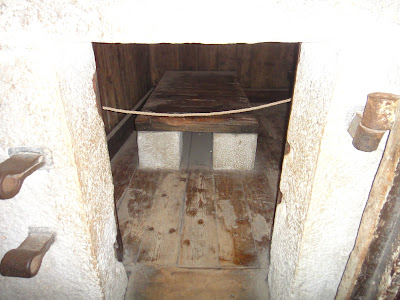Aboriginal Artwork (Taken in Melbourne)
To Aboriginal
people dreaming is not only the creation of life, but deals with everything and
all things about life. It tells the stories about how the earth and its
elements came to be, stories of the universe, and how the people should
interact with everything. In this culture everyone exists in the dreaming.
These beliefs are often viewed as a mythology in the western setting but for
the aboriginal people, it is a reality. The aboriginal guide I met in Sydney,
Evan, explained to me that the dreaming begins for every person in the fetus.
Each person has a spirit from before birth and will exist after the death of
that person as well. The past is a very important aspect of aboriginal culture.
The dreaming relates to past creation and spirits of those who have passed. Beyond
the creation stages of life, Dreamtime is used to outline the structure of
daily life. For example, rules in society, ceremonies, song lines, and daily
life are all part of the Dreaming.
Song lines are
often told to tell stories of the Dreaming. These dreaming stories and songs
differ throughout different indigenous clans across Australia but all cover
similar themes. Often times these stories are related to the land, animals,
people, vegetation, and sacred sites. These song lines are very educational in
providing information about all parts of the aboriginal lifestyle. Also, many
of the song lines have dances to accompany them for ceremonies and rituals.
Stories, dances and song lines have all been passed down through generations,
but some things are lost or changed. This also creates a difference in the
individual stories told in different areas.
Men's Sacred Site in Uluru
The dreamtime
involves rituals, some specific to men only and others women. This is called
“Men’s Business” and “Women’s Business.” Many of the sacred sites I saw at
Uluru were specific to one gender. Interestingly, Kata Tjuta (the Olgas) is
specific to Men’s Business only. This is amazing because this natural land
structure is over twice as tall as the Eiffel tower and longer than Ayer’s
Rock.
Uluru (Ayer's Rock)
The Aboriginal
people at Uluru, the Pitjantjatjara and
Yankunytjatjara, do not call the creation and the stories the Dreamtime. This
is because they do not believe the creation should be called a dream, as life
is a reality. They believe that the word “dreaming” refers to a non-reality or
changeable society, which these natives do not believe. “Dreaming” is not an
aboriginal word in their language and is only used by European Australians.
According to these natives, the world was originally empty before spirits
arrived in the form of humans to create the land, plants and animals.
At Uluru
The story of how Uluru was formed goes like this.
Two curious, uninitiated boys were traveling together when they heard a
ceremony of the Mala Wallaby people near Kata Tjuta. The Mala people ended up
being attacked by an evil spirit created by westerners, the Kurpany. It killed
many Mala people and the rest fled running from the evil creature. In the
meantime, the two boys began playing at their waterhole, creating mud by mixing
the dirt and water. They continued to pile up the mud until it became
Uluru. Then, they started sliding
and playing on the giant pile of mud. This is what created all of the gullies
after the mud hardened.
Aboriginal song lines and stories are a great way
of passing down traditions and culture. The Dreaming is considered the creation
of life and its elements by most aboriginal clans and is widely accepted as a
cultural belief in Australia.


















































